Quality Improvement of Laser-Induced Periodic Ripple Structures on Silicon Using a Bismuth-Indium Alloy Film
Abstract
1. Introduction
2. Experimental Details
3. Results and Discussions
3.1. Single-Spot Investigations on Silicon and BiIn-Si
3.2. Assistance Effect of Bi-In Alloy Film
3.3. Effect of Laser Fluence on the Fabrication of Nanostructures on BiIn-Si
3.4. Effect of the Laser Pulse Number on the Fabrication of Nanostructures on BiIn-Si
4. Conclusions
Author Contributions
Funding
Institutional Review Board Statement
Informed Consent Statement
Data Availability Statement
Conflicts of Interest
References
- Birnbaum, M. Semiconductor Surface Damage Produced by Ruby Lasers. J. Appl. Phys. 1965, 36, 3688–3689. [Google Scholar] [CrossRef]
- Höhm, S.; Rosenfeld, A.; Krüger, J.; Bonse, J. Femtosecond laser-induced periodic surface structures on silica. J. Appl. Phys. 2012, 112, 014901. [Google Scholar] [CrossRef]
- Van Driel, H.M.; Sipe, J.E.; Young, J.F. Laser-Induced Periodic Surface Structure on Solids: A Universal Phenomenon. Phys. Rev. Lett. 1982, 49, 1955–1958. [Google Scholar] [CrossRef]
- Wang, C.; Luo, Z.; Duan, J.; Jiang, L.; Sun, X.; Hu, Y.; Zhou, J.; Lu, Y. Adjustable annular rings of periodic surface structures induced by spatially shaped femtosecond laser. Laser Phys. Lett. 2015, 12, 056001. [Google Scholar] [CrossRef]
- Shi, X.; Xu, X. Laser fluence dependence of ripple formation on fused silica by femtosecond laser irradiation. Appl. Phys. A 2019, 125, 256. [Google Scholar] [CrossRef]
- Bonse, J.; Krüger, J. Pulse number dependence of laser-induced periodic surface structures for femtosecond laser irradiation of silicon. J. Appl. Phys. 2010, 108, 034903. [Google Scholar] [CrossRef]
- Gräf, S.; Müller, F.A. Polarisation-dependent generation of fs-laser induced periodic surface structures. Appl. Surf. Sci. 2015, 331, 150–155. [Google Scholar] [CrossRef]
- Gregorčič, P.; Sedlaček, M.; Podgornik, B.; Reif, J. Formation of laser-induced periodic surface structures (LIPSS) on tool steel by multiple picosecond laser pulses of different polarizations. Appl. Surf. Sci. 2016, 387, 698–706. [Google Scholar] [CrossRef]
- Albu, C.; Dinescu, A.; Filipescu, M.; Ulmeanu, M.; Zamfirescu, M. Periodical structures induced by femtosecond laser on metals in air and liquid environments. Appl. Surf. Sci. 2013, 278, 347–351. [Google Scholar] [CrossRef]
- Trtica, M.; Stasic, J.; Batani, D.; Benocci, R.; Narayanan, V.; Ciganovic, J. Laser-assisted surface modification of Ti-implant in air and water environment. Appl. Surf. Sci. 2018, 428, 669–675. [Google Scholar] [CrossRef]
- Vorobyev, A.Y.; Guo, C. Femtosecond laser-induced periodic surface structure formation on tungsten. J. Appl. Phys. 2008, 104, 063523. [Google Scholar] [CrossRef]
- Reif, J.; Costache, F.; Henyk, M.; Pandelov, S.V. Ripples revisited: Non-classical morphology at the bottom of femtosecond laser ablation craters in transparent dielectrics. Appl. Surf. Sci. 2002, 197–198, 891–895. [Google Scholar] [CrossRef]
- Shimotsuma, Y.; Kazansky, P.G.; Qiu, J.; Hirao, K. Self-Organized Nanogratings in Glass Irradiated by Ultrashort Light Pulses. Phys. Rev. Lett. 2003, 91, 247405. [Google Scholar] [CrossRef] [PubMed]
- Miyaji, G.; Miyazaki, K.; Zhang, K.; Yoshifuji, T.; Fujita, J. Mechanism of femtosecond-laser-induced periodic nanostructure formation on crystalline silicon surface immersed in water. Opt. Express 2012, 20, 14848–14856. [Google Scholar] [CrossRef]
- Garrelie, F.; Colombier, J.P.; Pigeon, F.; Tonchev, S.; Faure, N.; Bounhalli, M.; Reynaud, S.; Parriaux, O. Evidence of surface plasmon resonance in ultrafast laser-induced ripples. Opt. Express 2011, 19, 9035–9043. [Google Scholar] [CrossRef]
- Yang, Y.; Yang, J.; Xue, L.; Guo, Y. Surface patterning on periodicity of femtosecond laser-induced ripples. Appl. Phys. Lett. 2010, 97, 141101. [Google Scholar] [CrossRef]
- Bonse, J.; Rosenfeld, A.; Krüger, J. On the role of surface plasmon polaritons in the formation of laser-induced periodic surface structures upon irradiation of silicon by femtosecond-laser pulses. J. Appl. Phys. 2009, 106, 104910. [Google Scholar] [CrossRef]
- Vorobyev, A.Y.; Guo, C. Antireflection effect of femtosecond laser-induced periodic surface structures on silicon. Opt. Express 2011, 19, A1031–A1036. [Google Scholar] [CrossRef]
- Al-Kattan, A.; Ali, L.M.A.; Daurat, M.; Mattana, E.; Gary-Bobo, M. Biological Assessment of Laser-Synthesized Silicon Nanoparticles Effect in Two-Photon Photodynamic Therapy on Breast Cancer MCF-7 Cells. Nanomaterials 2020, 10, 1462. [Google Scholar] [CrossRef]
- Ebert, T.; Neumann, N.W.; Döhl, L.N.K.; Jarrett, J.; Baird, C.; Heathcote, R.; Hesse, M.; Hughes, A.; McKenna, P.; Neely, D.; et al. Enhanced brightness of a laser-driven x-ray and particle source by microstructured surfaces of silicon targets. Phys. Plasmas 2020, 27, 043106. [Google Scholar] [CrossRef]
- Mangaiyarkarasi, D.; Sheng, O.Y.; Breese, M.B.H.; Fuh, V.L.S.; Xioasong, E.T. Fabrication of large-area patterned porous silicon distributed Bragg reflectors. Opt. Express 2008, 16, 12757–12763. [Google Scholar] [CrossRef] [PubMed]
- Öktem, B.; Pavlov, I.; Ilday, S.; Kalaycıoğlu, H.; Rybak, A.; Yavaş, S.; Erdoğan, M.; Ilday, F.Ö. Nonlinear laser lithography for indefinitely large-area nanostructuring with femtosecond pulses. Nat. Photonics 2013, 7, 897–901. [Google Scholar] [CrossRef]
- Ardron, M.; Weston, N.; Hand, D. A practical technique for the generation of highly uniform LIPSS. Appl. Surf. Sci. 2014, 313, 123–131. [Google Scholar] [CrossRef]
- Feng, P.; Jiang, L.; Li, X.; Rong, W.; Zhang, K.; Cao, Q. Gold-film coating assisted femtosecond laser fabrication of large-area, uniform periodic surface structures. Appl. Opt. 2015, 54, 1314–1319. [Google Scholar] [CrossRef] [PubMed]
- Yang, H.Z.; Jiang, G.D.; Wang, W.J.; Mei, X.S.; Pan, A.F.; Zhai, Z.Y. Picosecond laser fabrication of nanostructures on ITO film surface assisted by pre-deposited Au film. Appl. Phys. B 2017, 123, 251. [Google Scholar] [CrossRef]
- Yin, K.; Wang, C.; Duan, J.; Guo, C. Femtosecond laser-induced periodic surface structural formation on sapphire with nanolayered gold coating. Appl. Phys. A 2016, 122, 834. [Google Scholar] [CrossRef]
- Jafari Eskandari, M.; Shafyei, A.; Razi, S.; Shoja Razavi, R. Influence of gold nanolayer coating on the continuous-wave laser ablation of a pure aluminum surface: Evaluations of structural and optical features. Thin Solid Film. 2019, 672, 126–132. [Google Scholar] [CrossRef]
- Kalantar-Zadeh, K.; Tang, J.; Daeneke, T.; O’Mullane, A.P.; Stewart, L.A.; Liu, J.; Majidi, C.; Ruoff, R.S.; Weiss, P.S.; Dickey, M.D. Emergence of Liquid Metals in Nanotechnology. ACS Nano 2019, 13, 7388–7395. [Google Scholar] [CrossRef]
- Daeneke, T.; Khoshmanesh, K.; Mahmood, N.; de Castro, I.A.; Esrafilzadeh, D.; Barrow, S.J.; Dickey, M.D.; Kalantar-zadeh, K. Liquid metals: Fundamentals and applications in chemistry. Chem. Soc. Rev. 2018, 47, 4073–4111. [Google Scholar] [CrossRef]
- Wang, W.; He, J.; Yan, D.; Samundsett, C.; Phang, S.P.; Huang, Z.; Shen, W.; Bullock, J.; Wan, Y. 21.3%-efficient n-type silicon solar cell with a full area rear TiOx/LiF/Al electron-selective contact. Sol. Energy Mater. Sol. Cells 2020, 206, 110291. [Google Scholar] [CrossRef]
- Wan, Y.; Samundsett, C.; Yan, D.; Allen, T.; Peng, J.; Cui, J.; Zhang, X.; Bullock, J.; Cuevas, A. A magnesium/amorphous silicon passivating contact for n-type crystalline silicon solar cells. Appl. Phys. Lett. 2016, 109, 113901. [Google Scholar] [CrossRef]
- Alexey, M.B.-B.; Mikhail, N.L.; Vladimir, S.M.; Vladimir, V.T. Surface electromagnetic waves in optics. Opt. Eng. 1992, 31, 718–730. [Google Scholar]
- Makinson, R.E.B. The thermal conductivity of metals. Math. Proc. Camb. Philos. Soc. 1938, 34, 474–497. [Google Scholar] [CrossRef]
- Ohno, S.; Tamaki, S. Electronic properties of liquid In-Bi alloys. J. Phys. Soc. Jpn. 1975, 38, 538–543. [Google Scholar] [CrossRef]
- Huang, M.; Zhao, F.; Cheng, Y.; Xu, N.; Xu, Z. Origin of Laser-Induced Near-Subwavelength Ripples: Interference between Surface Plasmons and Incident Laser. ACS Nano 2009, 3, 4062–4070. [Google Scholar] [CrossRef]
- Von der Linde, D.; Schüler, H. Breakdown threshold and plasma formation in femtosecond laser–solid interaction. J. Opt. Soc. Am. B 1996, 13, 216–222. [Google Scholar] [CrossRef]
- Han, Y.; Qu, S. The ripples and nanoparticles on silicon irradiated by femtosecond laser. Chem. Phys. Lett. 2010, 495, 241–244. [Google Scholar] [CrossRef]
- Liao, Y.; Pan, W.; Cui, Y.; Qiao, L.; Bellouard, Y.; Sugioka, K.; Cheng, Y. Formation of in-volume nanogratings with sub-100-nm periods in glass by femtosecond laser irradiation. Opt. Lett. 2015, 40, 3623–3626. [Google Scholar] [CrossRef]
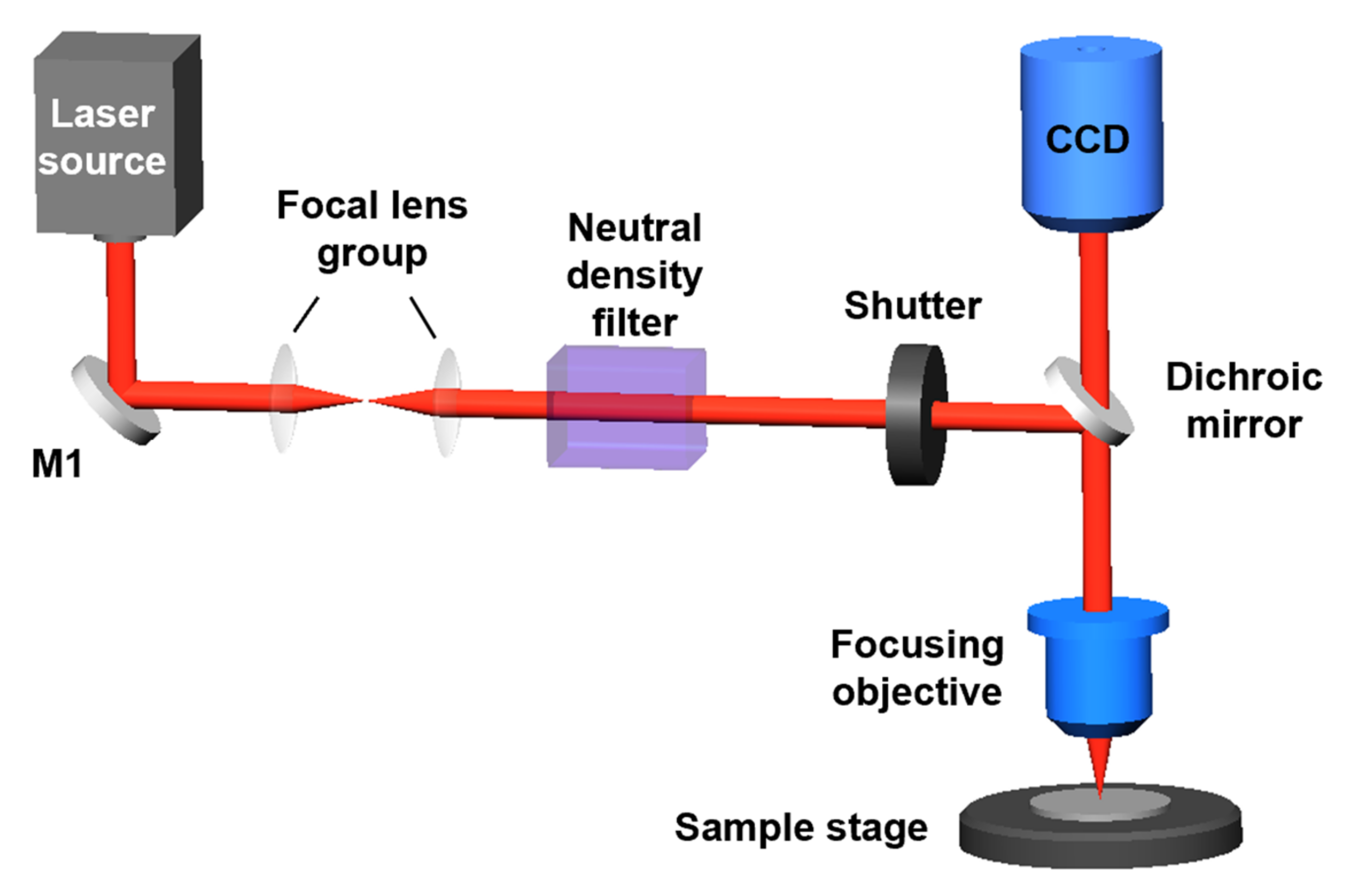
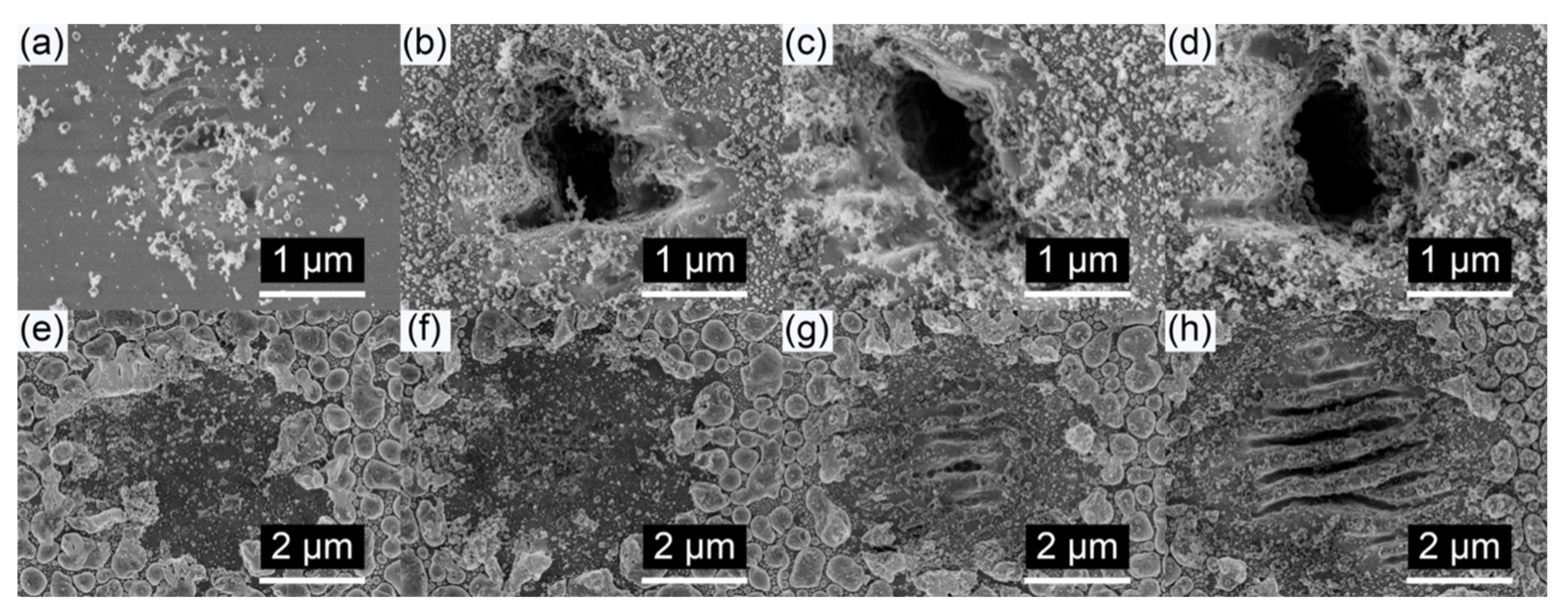
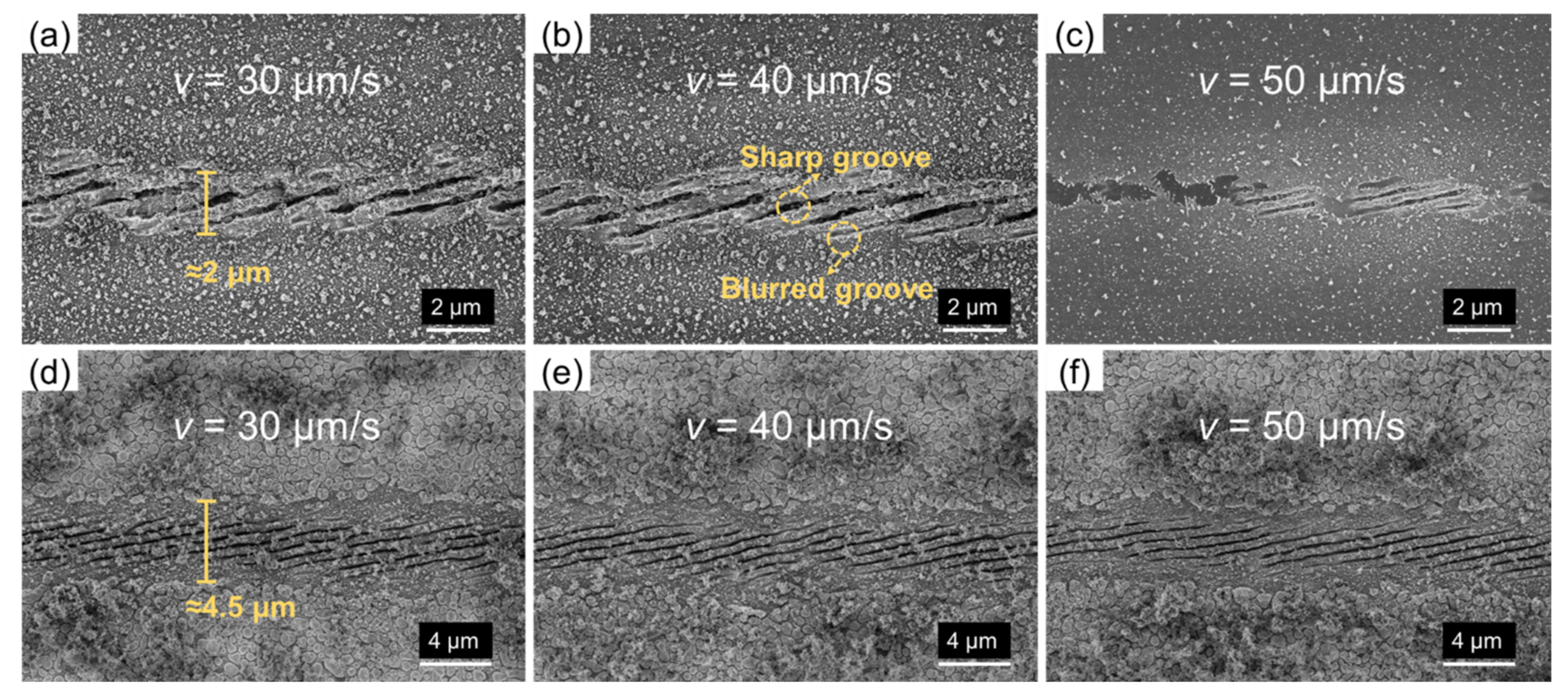

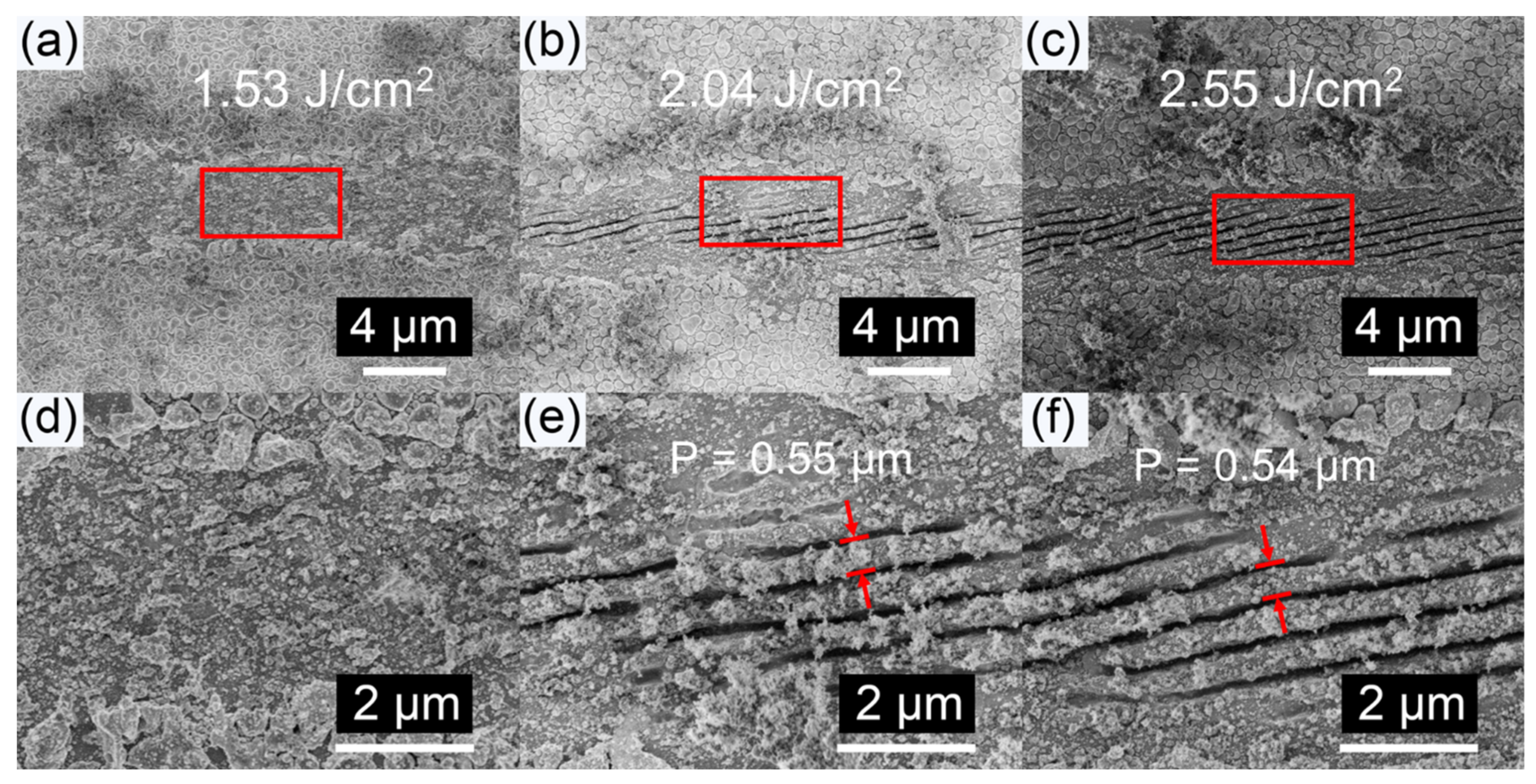
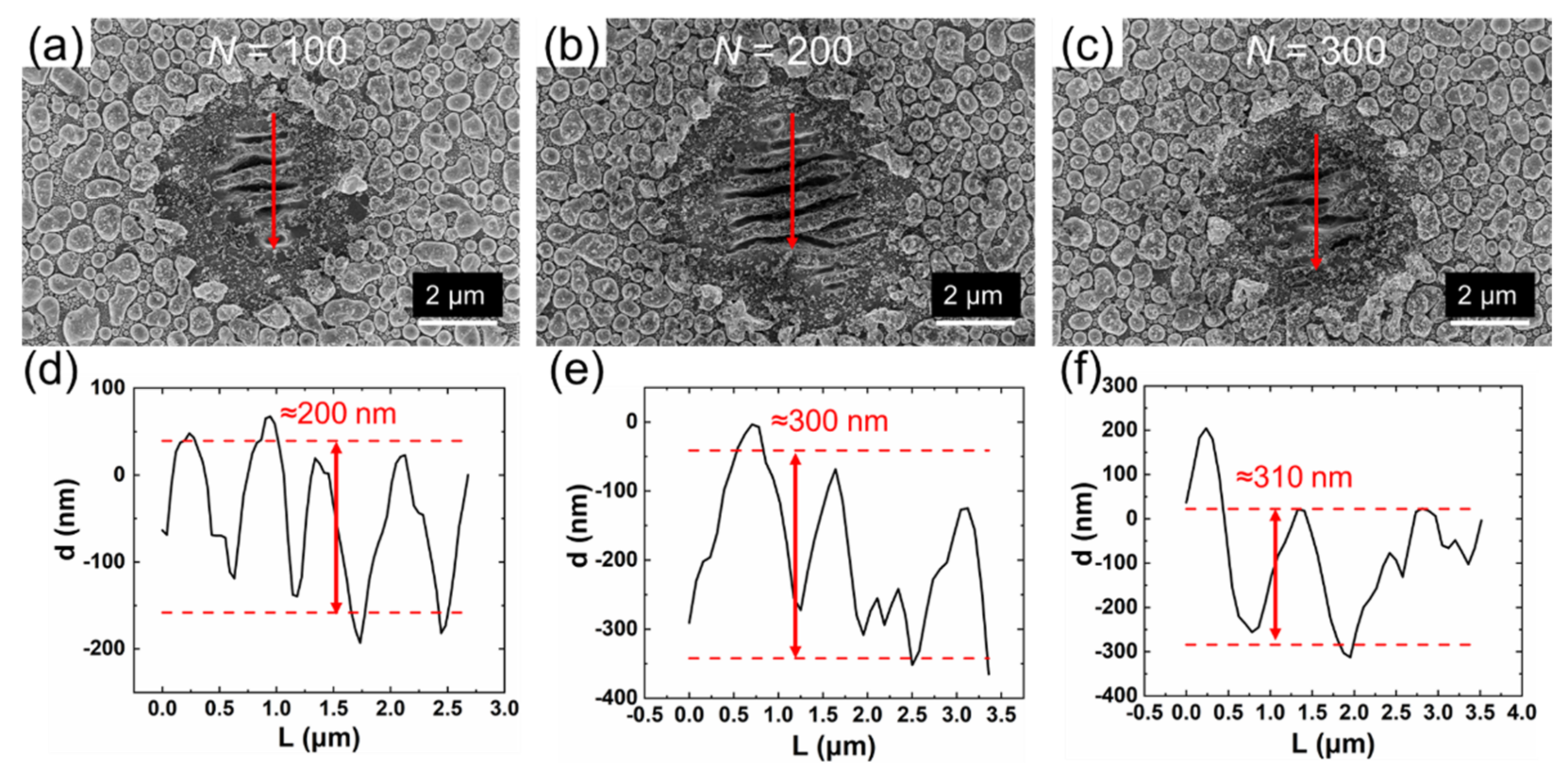
Publisher’s Note: MDPI stays neutral with regard to jurisdictional claims in published maps and institutional affiliations. |
© 2021 by the authors. Licensee MDPI, Basel, Switzerland. This article is an open access article distributed under the terms and conditions of the Creative Commons Attribution (CC BY) license (http://creativecommons.org/licenses/by/4.0/).
Share and Cite
Chen, Y.; Shan, Y.; Tu, H.; Zhang, H.; He, R.; Zheng, Y.; Zhang, R.; Wang, S.; Li, J.; Chen, L. Quality Improvement of Laser-Induced Periodic Ripple Structures on Silicon Using a Bismuth-Indium Alloy Film. Appl. Sci. 2021, 11, 632. https://doi.org/10.3390/app11020632
Chen Y, Shan Y, Tu H, Zhang H, He R, Zheng Y, Zhang R, Wang S, Li J, Chen L. Quality Improvement of Laser-Induced Periodic Ripple Structures on Silicon Using a Bismuth-Indium Alloy Film. Applied Sciences. 2021; 11(2):632. https://doi.org/10.3390/app11020632
Chicago/Turabian StyleChen, Yao, Yao Shan, Huatian Tu, Haotian Zhang, Rong He, Yuxiang Zheng, Rongjun Zhang, Songyou Wang, Jing Li, and Liangyao Chen. 2021. "Quality Improvement of Laser-Induced Periodic Ripple Structures on Silicon Using a Bismuth-Indium Alloy Film" Applied Sciences 11, no. 2: 632. https://doi.org/10.3390/app11020632
APA StyleChen, Y., Shan, Y., Tu, H., Zhang, H., He, R., Zheng, Y., Zhang, R., Wang, S., Li, J., & Chen, L. (2021). Quality Improvement of Laser-Induced Periodic Ripple Structures on Silicon Using a Bismuth-Indium Alloy Film. Applied Sciences, 11(2), 632. https://doi.org/10.3390/app11020632




